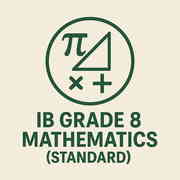Professional Courses
Industry-relevant training in Business, Technology, and Design
Categories
Interactive Games
Fun games to boost memory, math, typing, and English skills
Typing
Memory
Math
English Adventures
Knowledge

IB 8 Mathematics (Standard)
As an experienced online course creator specializing in the International Baccalaureate Middle Years Programme (IB MYP), I understand the nuances of crafting engaging, conceptually driven, and inquiry-based learning experiences. This course on IB Grade 8 Mathematics (Standard) is designed to empower students with a robust foundational understanding of mathematical concepts, develop their problem-solving skills, and foster an appreciation for the relevance of mathematics in a global context. Online Course: IB Grade 8 Mathematics (Standard) CourseWelcome to "IB Grade 8 Mathematics (Standard) - Navigating Numbers, Patterns, and Space," an interactive and comprehensive online course meticulously designed for students in the Middle Years Programme (MYP) Year 3. This course aligns perfectly with the IB MYP Mathematics Standard framework, emphasizing the acquisition of fundamental mathematical knowledge and the development of critical thinking, problem-solving, and communication skills. Beyond rote memorization, this course encourages an inquiry-based approach, inviting students to explore mathematical concepts through real-world problems and practical applications. We will delve into four key branches of mathematics: Number, Algebra, Geometry and Trigonometry, and Statistics and Probability, building upon prior knowledge and preparing students for future mathematical endeavors.
Course Chapters
Unit 1: Number Sense & Operations: Foundations for Fluency
Understanding the diverse forms of numbers and their relationships allows for logical interpretation and precise representation of quantities in complex real-world systems. The chapter covers the classification of numbers, focusing on rational and irrational numbers, their operations, and practical uses such as financial mathematics. Key mathematical concepts such as fractions, decimals, percentages, and ratios are also discussed, ultimately equipping learners with foundational number sense essential for fluency in mathematical problem-solving.
Unit 2: Algebraic Foundations: Unveiling Patterns & Relationships
The chapter provides a comprehensive overview of algebraic foundations, emphasizing the importance of expressions, equations, and their simplification. Key operations such as collecting like terms, expanding brackets, and factoring are illustrated with clear examples. The chapter also involves solving linear equations and inequalities, identifying patterns in sequences, and graphing linear relationships, providing students with essential tools to analyze and communicate mathematical concepts effectively.
Unit 3: Geometry of Shapes & Space: Exploring Form and Measurement
This chapter explores the essential properties and relationships of geometric shapes in both two and three dimensions. It covers key concepts such as angles, polygons, and the Pythagorean theorem, along with practical applications for measuring areas, perimeters, volumes, and surface areas of various shapes. By understanding these concepts, students will gain the ability to analyze and design structures in physical and abstract spaces.
Unit 4: Transformations, Congruence & Similarity: Shaping and Reshaping Space
The content explores the fascinating world of geometric transformations, including translations, reflections, rotations, and enlargements, explaining how these affect shapes' positions and sizes. Mastery of these transformations enables individuals to analyze visual patterns, apply geometric principles in real-world contexts, and communicate changes in orientations and sizes with mathematical precision. Furthermore, it delves into congruence and similarity, outlining the fundamental principles for identifying and proving the characteristics of shapes that maintain or alter their properties under various transformations.
Unit 5: Data Handling & Analysis: Making Sense of Information
The chapter focuses on the essential skills of collecting, organizing, analyzing, and interpreting data in a data-driven world. It introduces the types of data, how to create and utilize frequency and grouped frequency tables, methods for visualizing data through various graphs, and techniques for calculating measures of central tendency and spread. The emphasis on real-world applications, effective data interpretation, and the importance of critical thinking in analyzing data representation reinforces the fundamental concepts of data handling and analysis.
Unit 6: Probability & Chance: Quantifying Uncertainty
Probability quantifies uncertainty, enabling informed predictions and decision-making in various contexts. The chapter covers theoretical probability based on logical reasoning, experimental probability derived from actual experiments, and independent events, along with their relationships using Venn diagrams. By understanding these concepts, learners can apply mathematical principles to evaluate the likelihood of various outcomes effectively.
Unit 7: Mathematical Inquiry & Real-World Application: Synthesizing Knowledge
Mathematics serves as a vital tool in addressing complex real-world problems through inquiry and application of learned concepts. The unit emphasizes synthesizing knowledge from various mathematical domains, focusing on problem-solving strategies, and communicating solutions effectively. Key themes include engaging with multi-step challenges, modeling real-world scenarios, and justifying mathematical reasoning.
